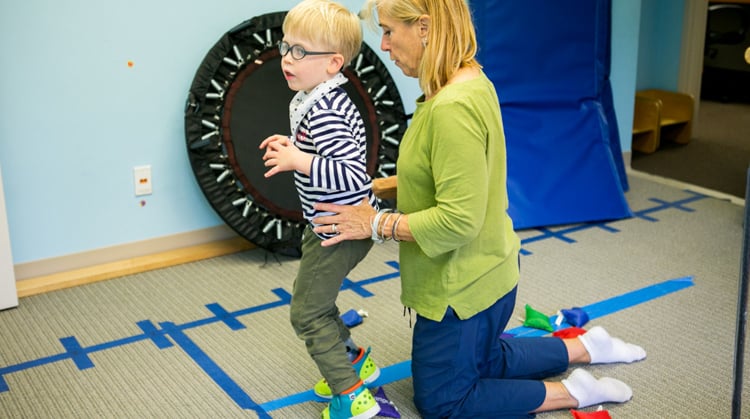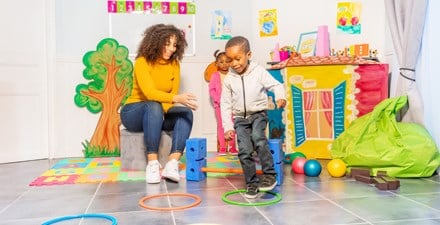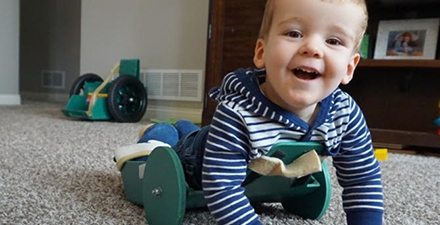Physical Therapy Guide to Spina Bifida
Spina bifida occurs when an infant's spinal cord does not develop correctly during prenatal (before birth) development. Roughly 1,500 babies born in the United States are diagnosed with spina bifida each year. Spina bifida may cause both physical and cognitive (learning or thinking) disabilities.
An infant born with spina bifida will have a team of health care providers to address their needs from birth. Physical therapists play an important role on these teams and in the lives of people with spina bifida. Working with a physical therapist from birth helps children with spina bifida reach developmental milestones and improve how they move. Physical therapists also help to prevent or reduce long-term problems and complications (things that worsen symptoms) of spina bifida.
Physical therapists are movement experts who improve quality of life through:
- Hands-on care.
- Patient education.
- Prescribed movement.
You can contact a physical therapist directly for an evaluation. To locate a physical therapist in your area, visit Find a PT.
What Is Spina Bifida?
Spina bifida is a defect involving the spine and spinal cord. It occurs when an infant's neural tube (the early version of the spinal cord) does not fully close during the first month of pregnancy. When this happens, the bones protecting the spinal cord do not form correctly. Spina bifida often results in damage to the spinal cord and surrounding nerves. It can occur anywhere along the spinal cord. Spina bifida is a condition a person will have for their entire life.
The three most common types of spina bifida are:
- Myelomeningocele. Nerve tissue, the spinal cord, and spinal fluid push through an opening somewhere along the spinal column. This condition produces a visible sac on the baby's back. It results in nerve damage that limits a person's ability to function in basic life activities. Physical problems range from moderate to severe. This is the most severe form of spina bifida.
- Meningocele. Nerve tissue and spinal fluid push through an opening in the spinal column. This produces a visible sac on the baby's back but no nerve damage. Physical problems are generally minor.
- Spina bifida occulta. A gap or opening occurs in one or more of the vertebrae (bones) of the spine. Spina bifida occulta is often referred to as "hidden." There is no visible sac on the baby's back, and a layer of skin covers the defect. Nerve damage generally does not occur. Spina bifida occulta rarely causes problems or symptoms and may go unnoticed. This is the most common and mildest form of spina bifida.
Signs and Symptoms
Spina bifida may cause both physical and cognitive limitations (problems) ranging from mild to severe. How severe these limitations are depends on:
- The size and location of the opening in the spine.
- How much of the spinal cord and nerves are included.
- Other problems common with spina bifida.
When the defect is higher in the spine, it usually causes more physical problems. Spina bifida in the lower levels of the spine and spinal cord is more common.
Depending on the defect's location, the areas affected may be the:
- Cervical section (neck area); controls arms and hands.
- Thoracic section (upper back area); controls trunk and abdomen.
- Lumbar section (lower back area); controls legs.
- Sacral section (below the low back into the tailbone area); controls parts of the legs, as well as the bowel and bladder.
Below are some common symptoms of spina bifida:
- Difficulty moving the legs for activities such as crawling and walking.
- Problems with blood flow in the legs from limited muscle use. This increases the risk for pressure sores and poor healing of wounds.
- Weak bones and joints, or bones that are curved or misshaped.
- Weak or paralyzed legs from damage to the spinal cord and nerves.
- Decreased sensation or feeling.
- Problems going to the bathroom, such as trouble controlling both bowel and bladder functions.
- Problems with sexual function.
- Sensitive skin, including latex allergies.
There are also a few common conditions that may occur along with spina bifida. They are:
- Chiari II malformation (deformity). Part of the brain pushes through the opening at the bottom of the skull. This condition can cause headaches, neck pain, and trouble swallowing or speaking.
- Hydrocephalus. Too much fluid builds up around the brain. This can increase pressure on the brain. Doctors may insert a shunt to move the fluid away from the brain. A person with this condition may have learning and attention problems.
- Tethered spinal cord. Part of the spinal cord attaches to the bony defect. This defect causes the spinal cord to stretch with growth. This condition can lead to other problems with the legs and mobility.
How Is It Diagnosed?
Doctors often diagnose spina bifida during pregnancy through:
- Ultrasound.
- Amniocentesis (testing the amniotic fluid surrounding the baby).
- AFP test (a test of the mother's blood).
Spina bifida often is detected as early as 16 to 18 weeks of pregnancy. However, if the spinal opening is small or hidden, it may not be found until birth or when symptoms start. An X-ray helps doctors diagnose these cases.
Spina bifida meningocele and myelomeningocele usually require surgery within a couple of days after birth. Surgery is sometimes possible during pregnancy if the mother and baby meet specific requirements. Surgery during pregnancy can improve outcomes by two spinal levels of function. Surgery before birth also can help the child be more mobile and may prevent other related health problems. However, a risk of surgery during pregnancy is premature delivery (early birth).
After birth, a physical therapist will help determine how much the child can move their body. They also measure any sensation (ability to feel) affected by the defect.
How Can a Physical Therapist Help?

A physical therapist is an important partner in the health and well-being of anyone with spina bifida. Physical therapists help children and adults gain and keep mobility through all life stages. Physical therapists also work with various other health care providers to address each person's unique needs. Treatment priorities will shift from early childhood into adulthood.
Your physical therapist will perform a thorough evaluation of your child that includes:
- Birth and developmental history. Your physical therapist will ask questions about your child's birth and development. This will include gathering information about your child's age when they rolled over, sat up, crawled, walked, etc.
- General health questions. Your child's physical therapist will ask questions about your child's general health. These may include questions about past doctor or therapy visits, vaccinations, hospital visits, and injuries.
- Parental concerns. Your child's physical therapist will ask about your main concerns and what you hope to achieve in therapy?
- Physical exam. The physical exam includes watching how your child moves. Your child's physical therapist also will do a hands-on assessment. This will include testing muscle strength and flexibility, balance, and coordination. They also may assess your child's ability to feel and control muscles at or below the defect level.
- Motor development tests. Your child's physical therapist will perform specific tests to determine your child's motor development. This will include assessing their ability to sit, crawl, pull up to stand, and walk. They also may screen your child's hand use, vision, language, and cognitive skills. This will help them decide if your child needs support from other services.
- Referrals. Your child's physical therapist may refer your child to other health care providers. They will work together with your entire health care team to address your child's needs and ensure the best possible care.
Physical therapists provide treatment in a variety of settings. The setting where your child receives physical therapy may change or overlap, depending on their age, growth stage, and goals.
Physical therapy will include:
- Exercises.
- Activities.
- Recommending any needed supportive equipment.
- Tracking your child's progress.
The following are examples of the types of physical therapy provided by setting:
- Intensive care unit. Physical therapists address infant positioning needs and provide parent and family education.
- Early intervention. Physical therapy early in life is called early intervention. It encourages infants and young children to develop strength, movement, and balance skills. Physical therapists also teach parents specific play-based exercises that they can do with their child. Early intervention programs are available in every state and territory. These publicly funded programs provide services in the home and community. Services may be free or provided at a reduced cost for any eligible child.
- School-based. Physical therapy at school helps students with spina bifida take part in school activities. Your child's physical therapist will work with the educational team and recommend special equipment to use at school.
- Outpatient. Physical therapy in a clinic setting includes working on exercises and mobility activities. These activities will be specific to the needs of each child or adult with spina bifida. Physical therapists work with adults who have spina bifida to help them:
- Keep their strength and flexibility.
- Prevent or reduce related problems.
- Take part in home, work, and leisure activities.
Physical therapy treatment for children or adults with spina bifida may include:
- Exercises and activities. Physical therapists use many kinds of exercises and activities to improve physical function. They help children and adults with spina bifida take part in play, school, home, and work activities. Activities selected will be specific to each person's needs and goals. Your physical therapist will progress and change activities and exercises, as needed, to achieve the greatest benefit. Exercises may include:
- Gait training (learning to walk with or without assistive devices).
- Treadmill training.
- Exercises to improve strength and balance.
- Stretching.
- Home exercise programs. Parents, guardians, family members, and the child or adult are all part of the health care team. Physical therapists design home exercise programs that can be continued outside the clinic.
- Equipment and assistive devices. Physical therapists recommend equipment to help people with spina bifida move around and access their environment. These may include:
- Orthotics/braces.
- Walkers or crutches.
- Standers or wheelchairs.
Can This Injury or Condition Be Prevented?
There is no guaranteed way to prevent spina bifida. However, taking the doctor recommended amount of folic acid before and during early pregnancy can help lower the chances of a baby having spina bifida. Other ways women can lower the risk include managing or avoiding:
- Certain medicines (check with your OB-GYN).
- Diabetes and obesity.
- Fevers and overheating the body.
Physical therapy can help people with spina bifida prevent other possible problems. Problems that physical therapists can help prevent include:
- Obesity.
- Contractures (limited joint movement caused by tightened and shortened muscles and tissues that connect or support organs and bones).
- Fractures (breaks in the bones).
- Scoliosis (a condition in which the backbone curves to the side).
Physical therapists identify activities to encourage movement and muscle strength to promote lifelong health and wellness.
What Kind of Physical Therapist Do I Need?
All physical therapists are prepared through education and experience to treat a variety of conditions or injuries. However, you may want to consider:
- A physical therapist who is experienced in pediatrics and developmental disorders. Some physical therapists have a pediatric practice. They may work in the clinic, home, school, or community.
- A physical therapist who is a board-certified clinical specialist or who has completed a residency or fellowship in pediatric or neurological physical therapy. This physical therapist has advanced knowledge, experience, and skills in developmental conditions such as spina bifida.
- An experienced pediatric physical therapist who also understands the importance of working with other health care providers to achieve the best possible outcomes for people with spina bifida.
You can find physical therapists in your area with these credentials and clinical expertise on Find a PT, a tool built by the American Physical Therapy Association.
General tips when you are looking for a physical therapist (or any other health care provider):
- Get recommendations from family, friends, or other health care providers.
- When you contact a physical therapy clinic or home health agency for an appointment, ask about the physical therapists' experience in helping children with spina bifida or other developmental disorders.
- Be prepared to describe your symptoms in as much detail as possible during your first visit. Make a note of what makes your symptoms better or worse.
The APTA Academy of Pediatric Physical Therapy contributed to this consumer resource. It is for informational purposes only and is not intended to represent the position of APTA Pediatrics.
The American Physical Therapy Association believes that consumers should have access to information to help them make informed health care decisions and prepare them for their visit with a health care provider.
The following resources offer some of the best scientific evidence related to physical therapy treatment for spina bifida. They report recent research and give an overview of the standards of practice both in the United States and internationally. They link to a PubMed* abstract that also may offer free access to the full text, or to other resources. You can read them or print out a copy to bring with you to your health care provider.
Iftikhar W, De Jesus O. Spinal dysraphism and myelomeningocele. In: StatPearls. Treasure Island, FL: StatPearls Publishing; 2021. Article Summary in PubMed.
Bhandari J, Thada PK. Neural tube disorders. In: StatPearls. Treasure Island (FL): StatPearls Publishing; October 16, 2020. Article Summary in PubMed.
Houtrow AJ, Thom EA, Fletcher JM, et al. Prenatal repair of myelomeningocele and school-age functional outcomes. Pediatrics. 2020;145(2):e20191544. Article Summary in PubMed.
Centers for Disease Control and Prevention. Data and statistics on spina bifida. https://www.cdc.gov/spina-bifida/data/?CDC_AAref_Val=https://www.cdc.gov/ncbddd/spinabifida/data.html. Published September 3, 2020. Accessed December 9, 2020.
Centers for Disease Control and Prevention. About spina bifida. Centers for Disease Control and Prevention. https://www.cdc.gov/spina-bifida/about/?CDC_AAref_Val=https://www.cdc.gov/ncbddd/spinabifida/facts.html. Published January 2, 2025. Accessed March 10, 2025.
Centers for Disease Control and Prevention. Manage spina bifida. https://www.cdc.gov/spina-bifida/treatment/?CDC_AAref_Val=https://www.cdc.gov/ncbddd/spinabifida/treatment.html. Published January 2, 2025. Accessed March 10, 2025.
National Institute of Neurological Disorders and Stroke. Spina bifida fact sheet. https://www.ninds.nih.gov/health-information/disorders/spina-bifida. Updated January 27, 2023. Accessed February 13, 2023.
Spina Bifida Association. What is spina bifida?. https://www.spinabifidaassociation.org/what-is-spina-bifida-2/. Published September 15, 2020. Accessed December 9, 2020.
March of Dimes. Spina bifida. March of Dimes. https://www.marchofdimes.org/complications/spina-bifida.aspx. Published June 2019. Accessed December 9, 2020.
Inversetti A, Van der Veeken L, Thompson D, et al. Neurodevelopmental outcome of children with spina bifida aperta repaired prenatally vs postnatally: systematic review and meta-analysis. Ultrasound Obstet Gynecol. 2019;53(3):293–301. Article Summary in PubMed.
Lee DK, Muraszko K, Ulrich BD. Bone mineral content in infants with myelomeningocele, with and without treadmill stepping practice. Pediatr Phys Ther. 2016;28(1):24–32. Article Summary in PubMed.
Ivanyi B, Schoenmakers M, van Veen N, Maathuis K, Nollet F, Nederhand M. The effects of orthoses, footwear, and walking aids on the walking ability of children and adolescents with spina bifida: a systematic review using International Classification of Functioning, Disability and Health for Children and Youth (ICF-CY) as a reference framework. Prosthet Orthot Int. 2015;39(6):437–443. Article Summary in PubMed.
*PubMed is a free online resource developed by the National Center for Biotechnology Information. PubMed contains millions of citations to biomedical literature, including citations in the National Library of Medicine's MEDLINE database.
Expert Review:
May 28, 2021
Revised:
May 28, 2021
Content Type: Guide
Spina Bifida
PT, DPT, on behalf of the APTA Academy of Pediatric Physical Therapy
Anna V. Howard
PT, DPT, board-certified clinical specialist in pediatric physical therapy and certified neonatal therapist, on behalf of the APTA Academy of Pediatric Physical Therapy
You Might Also Like...
Health Tips
Tips to Select Toys for Children with Special NeedsSep 3, 2024
Play has an important role in the growth and development of children of all abilities, but it is particularly valuable for children with special needs
Podcast
A Father’s Invention Offers Hope for Kids with Spinal Cord InjuriesFeb 5, 2020
He faces major challenges from paralysis due to spina bifida. Thanks to a physical therapy and an invention, Brody, is getting around.

